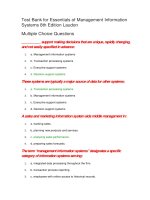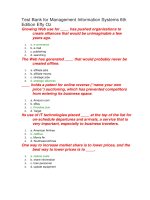Enterprise manage information systems 6th by laudon ch07
Bạn đang xem bản rút gọn của tài liệu. Xem và tải ngay bản đầy đủ của tài liệu tại đây (695 KB, 52 trang )
Chapter 7
Essentials of Management Information Systems, 6e
Chapter 7 Managing Data Resources
Managing Data Resources
7.1
© 2005 by Prentice Hall
Essentials of Management Information Systems, 6e
Chapter 7 Managing Data Resources
Objectives
1. Why do businesses have trouble finding the
information they need in their information
systems?
2. How does a database management system help
businesses improve the organization of their
information?
7.2
© 2005 by Prentice Hall
Essentials of Management Information Systems, 6e
Chapter 7 Managing Data Resources
Objectives
3. How do the principal types of database models
affect the way businesses can access and use
information?
4. What are the managerial and organizational
requirements of a database environment?
5. What new tools and technologies can make
databases more accessible and useful?
7.3
© 2005 by Prentice Hall
Essentials of Management Information Systems, 6e
Chapter 7 Managing Data Resources
Management Challenges
1. Organizational obstacles to a database
environment
2. Cost/benefit considerations
7.4
© 2005 by Prentice Hall
Essentials of Management Information Systems, 6e
Chapter 7 Managing Data Resources
Organizing Data in a Traditional File Environment
File Organization Terms and Concepts
• Bit: Smallest unit of data; binary digit (0,1)
• Byte: Group of bits that represents a single character
• Field: Group of words or complete number
• Record: Group of related fields
• File: Group of records of the same type
7.5
© 2005 by Prentice Hall
Essentials of Management Information Systems, 6e
Chapter 7 Managing Data Resources
Organizing Data in a Traditional File Environment
File Organization Terms and Concepts
• Database: Group of related files
• Entity: Person, place, thing, or event about which
information must be kept
• Attribute: A piece of information describing a
particular entity
• Key field: Field that uniquely identifies every
record in a file
7.6
© 2005 by Prentice Hall
Essentials of Management Information Systems, 6e
Chapter 7 Managing Data Resources
Organizing Data in a Traditional File Environment
The data hierarchy
Figure 7-1
7.7
© 2005 by Prentice Hall
Essentials of Management Information Systems, 6e
Chapter 7 Managing Data Resources
Organizing Data in a Traditional File Environment
Entities and attributes
Figure 7-2
7.8
© 2005 by Prentice Hall
Essentials of Management Information Systems, 6e
Chapter 7 Managing Data Resources
Organizing Data in a Traditional File Environment
Problems with the Traditional File Environment
• Data redundancy
• Program-data dependence
• Lack of flexibility
• Poor security
• Lack of data-sharing and availability
7.9
© 2005 by Prentice Hall
Essentials of Management Information Systems, 6e
Chapter 7 Managing Data Resources
Organizing Data in a Traditional File Environment
Traditional file processing
Figure 7-3
7.10
© 2005 by Prentice Hall
Essentials of Management Information Systems, 6e
Chapter 7 Managing Data Resources
The Database Approach to Data Management
Database Management Systems
Database
• Collection of centralized data
• Controls redundant data
• Data stored so as to appear to users in one location
• Services multiple application
7.11
© 2005 by Prentice Hall
Essentials of Management Information Systems, 6e
Chapter 7 Managing Data Resources
The Database Approach to Data Management
The contemporary database environment
Figure 7-4
7.12
© 2005 by Prentice Hall
Essentials of Management Information Systems, 6e
Chapter 7 Managing Data Resources
The Database Approach to Data Management
Database Management Systems
Database Management System (DBMS)
• Creates and maintains databases
• Eliminates requirement for data definition
statements
• Acts as interface between application programs
and physical data files
• Separates logical and physical views of data
7.13
© 2005 by Prentice Hall
Essentials of Management Information Systems, 6e
Chapter 7 Managing Data Resources
The Database Approach to Data Management
Database Management Systems
Three Components to a DBMS
1. Data definition language: Formal language
programmers use to specify structure of database
2. Data manipulation language: For extracting data
from database, e.g. SQL
3. Data dictionary: Tool for storing, organizing
definitions of data elements and data
characteristics
7.14
© 2005 by Prentice Hall
Essentials of Management Information Systems, 6e
Chapter 7 Managing Data Resources
The Database Approach to Data Management
Sample data dictionary report
Figure 7-5
7.15
© 2005 by Prentice Hall
Essentials of Management Information Systems, 6e
Chapter 7 Managing Data Resources
The Database Approach to Data Management
Database Management Systems
How a DBMS Solves Problems of a
Traditional File Environment
•
•
•
•
•
7.16
Reduces data redundancy
Eliminates data inconsistency
Uncouples programs from data
Increases access and availability of data
Allows central management of data, data use, and
security
© 2005 by Prentice Hall
Essentials of Management Information Systems, 6e
Chapter 7 Managing Data Resources
The Database Approach to Data Management
Types of Databases
Relational DBMS
• Represents data as two-dimensional tables called
relations
• Relates data across tables based on common data
element
• Examples: DB2, Oracle, MS SQL Server
7.17
© 2005 by Prentice Hall
Essentials of Management Information Systems, 6e
Chapter 7 Managing Data Resources
The Database Approach to Data Management
The relational data model
Figure 7-6
7.18
© 2005 by Prentice Hall
Essentials of Management Information Systems, 6e
Chapter 7 Managing Data Resources
The Database Approach to Data Management
Types of Databases
Three Basic Operations in a Relational Database
• Select: Creates subset of rows that meet specific
criteria
• Join: Combines relational tables to provide users
with information
• Project: Enables users to create new tables
containing only relevant information
7.19
© 2005 by Prentice Hall
Essentials of Management Information Systems, 6e
Chapter 7 Managing Data Resources
The Database Approach to Data Management
The three basic operations of a relational DBMS
Figure 7-7
7.20
© 2005 by Prentice Hall
Essentials of Management Information Systems, 6e
Chapter 7 Managing Data Resources
The Database Approach to Data Management
Types of Databases
Hierarchical DBMS
• Older system presenting data in tree-like structure
• Models one-to-many parent-child relationships
• Found in large legacy systems requiring intensive highvolume transactions: Banks; insurance companies
• Examples: IBMs IMS
7.21
© 2005 by Prentice Hall
Essentials of Management Information Systems, 6e
Chapter 7 Managing Data Resources
The Database Approach to Data Management
A hierarchical database for a human resources system
Figure 7-8
7.22
© 2005 by Prentice Hall
Essentials of Management Information Systems, 6e
Chapter 7 Managing Data Resources
The Database Approach to Data Management
Types of Databases
Network DBMS
• Older logical database model
• Models many-to-many parent-child relationships
• Example: Student – course relationship: Each
student has many courses; each course has many
students
7.23
© 2005 by Prentice Hall
Essentials of Management Information Systems, 6e
Chapter 7 Managing Data Resources
The Database Approach to Data Management
The network data model
Figure 7-9
7.24
© 2005 by Prentice Hall
Essentials of Management Information Systems, 6e
Chapter 7 Managing Data Resources
The Database Approach to Data Management
Types of Databases
Disadvantages of Hierarchical and
Network DBMS
• Outdated
• Less flexible compared to RDBMS
• Lack support for ad-hoc and English language-like
queries
7.25
© 2005 by Prentice Hall









